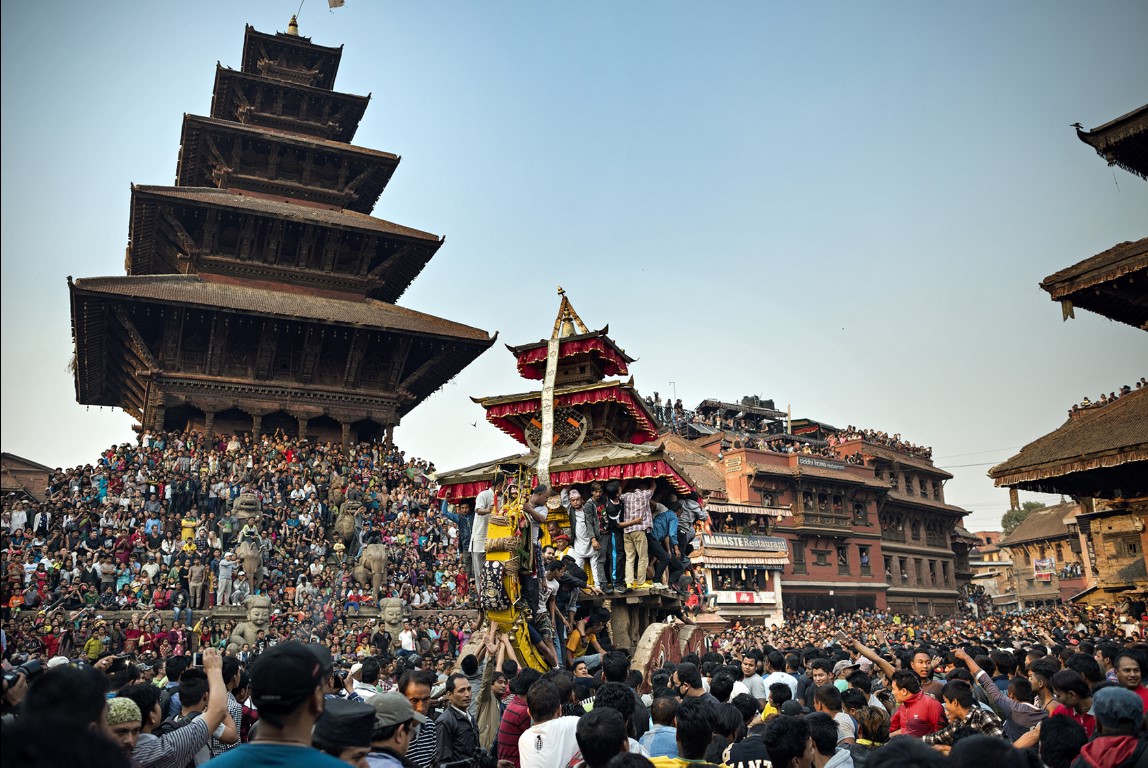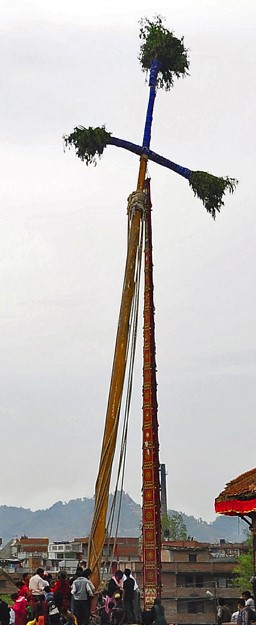Bhaktapur is a pretty ancient city that, from a bird’s eye view, is supposed to have the shape of a flying pigeon, and besides being the origin of the original Nepali cap, the Bhadgaunle topi, and the original dress of Newari women of the Valley, the haku-patasi, is where the ‘King of Curds’, that is, Juju Dhau, was born. There’s also a festival held in this city that’s like no other, adding yet another feather in its already well-embellished cap. It is held for nine days around the Nepali New Year (from April11-18, this year; April 14 being the New Year)), and its main claim to fame is that it’s easily the most boisterous festival in a country that has a number of lively festivals every month, if not every week.
It’s known as Bisket Jatra, and its focal point are two massive raths (chariots) with mammoth wheels that are pulled with ropes through the streets and alleys of the city. The larger of the two carries Lord Bhairab, while the smaller one has Goddess Bhadrakali inside, and some other lesser deities accompany them on their journey on palanquins. The tallest temple in the country, the eighteenth century, five-storied, 30-meter-tall Nyatapola Temple in Taumadhi Square is where it all begins, it being the starting point of the splendid parade of the gods.
Swarms of young men vie to give a strong hand in pulling the sturdy ropes that pull the raths along inch by inch. It’s a herculean task that much is for sure, and as the procession makes its lumbering way through the narrow streets and narrower gallis (alleyways), the crowds swell in number manifold, both pullers and spectators equally enthusiastic in their unrestrained fervor. At certain specific localities of the city, the raths are rested for the night, giving an opportunity for inhabitants of the locality to come and pay their respects to the gods.
The day before the dawning of the New Year, two 55-ft-tall wooden poles, known as lingos, are erected in two places of the city; one in Yosinkhel, and the other in Pottery Square. Come New Year day, and the lingo in Yosinkhel is brought down to earth with a resounding crash. This has to do with the myth behind the festival, and symbolizes the killing of the villain snake of the myth (will come to it later). The two raths, meanwhile, are made to crash against each other. This is also symbolic of the climatic event of the said myth, the consummation of the wedding night of the princess and her beau (hold on, I’ll be talking about it a few lines down). On the last day of the festival, the lingo at Pottery Square is also brought down with a crash.
Although it reads like an enjoyable enough festival, truth is, the hordes from different sides of the city try with all their might, and generally, inebriated vigor, to pull the massive rath bearing the three-tiered temple of Lord Bhairab towards their own localities. The ensuing bedlam, due to this tug-of-war, is a spectacle that is as exciting as it is dangerous. No wonder there have been quite a few fatalities during this festival in the past years. The bringing down of the heavy lingos is also a rowdy affair, and here, too, injuries are common, because groups come to loggerheads here, as well, for the privilege of bringing them down. All these spirited activities, and the thousands and thousands of excited spectators, make this a festival like no other.

Now, coming to the myth behind it, there was once a king called Jagajyoti Malla who had a childlike fondness for fables. He especially like the story of the princess who was under a terrible curse, according to which, whoever married her would die the morning after the wedding, and that too without consummating the marriage. A number of young men had lost their lives in this way. However, along came a brave lad who said he would give it a try. He was smart, too, and had decided that he wouldn’t sleep a wink on the fateful night, and would have a sword by his side.

Came the night in question, and as soon as her head hit the pillow, the princess had fallen into a deep sleep. The young lad, however, did not close his eyes at all, and kept looking around the room, and from time to time, at his fast asleep wife. All was normal till about midnight, and then his eyes again fell on the princess, and what should his unbelieving eyes see but a couple of reptiles crawling out of her gently flaring nostrils. For a few moments he was transfixed, and then coming to his senses, he swiftly pulled out his sword and began cutting the snakes into ribbons. And so, that was how his life was saved, and he succeeded in consummating his marriage as well.
So beloved was this tale to King Malla that he ordered his subjects to have a festival every year to ensure that it was never forgotten, and that it would be known by future generations. Bisket Jatra, originally known as Bisyau Jatra, was what resulted, and thanks to the love of myths by a childlike king, Bhaktapur had one more cultural event to be proud of.








